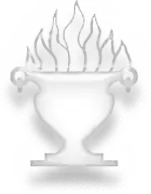Frahang-i Pahlavig
Frahang-ī Pahlavīg (Middle Persian: 𐭯𐭥𐭧𐭭𐭢 𐭯𐭧𐭫𐭥𐭩𐭪 "Pahlavi dictionary") is the title of an anonymous dictionary of mostly Aramaic logograms with Middle Persian translations (in Pahlavi script) and transliterations (in Pazend script).[1] Its date is unknown.
The glossary was previously known to Indian Zoroastrians, called the Parsis, as the mna-xvatay (traditionally pronounced mona khoda), a name derived from the first two words (the lemma) of the first entry.[2]
Relevant scripts' characteristics
The Pazend script has the following characteristics, as contrasted with the Pahlavi script:
- Pazend is a variant of the Avestan alphabet (Din dabireh), a phonetic alphabet. In contrast, Pahlavi is only an abjad.
- Pazend does not have ideograms. In contrast, ideograms are an identifying feature of the Pahlavi system, and are words borrowed from Semitic languages such as Aramaic that continue to be spelled as in Aramaic transliterated into the Pahlavi script, yet are pronounced as the corresponding word in Persian.
Manuscripts and interpretations
The oldest surviving example of a Frahang-like text is a one-page fragment discovered at Turpan that is believed to date to the 9th or 10th century CE. Several more complete manuscripts exist in Bombay, Oxford, Paris, and Copenhagen, but the oldest of these dates to the 15th century and is missing a second folio and all of folio 28 onwards. In the earliest edition made available to European scholarship, the Frahang is arranged serially; that is, according to the shape of the Aramaic characters. That edition, obtained by Abraham Anquetil-Duperron in the mid-18th century, is today in the Bibliothèque nationale, Paris. In 1867, Hoshangji Jamaspji Asa and Martin Haug published a transcript of a manuscript that was arranged thematically by chapter.
The existence of similar glossaries from Akkadian times (explaining Sumerian logograms) led an Assyriologist, Erich Ebeling, to explain that many of the words in the Frahang were derived from Sumerian or Akkadian. This led to a number of "far-fetched interpretations,"[3] which were then subsequently incorporated into a number of later interpretations, including those of Iranists, so effectively making even these unreliable.
Structure and content
The glossary encompasses approximately five hundred (not counting variations) Semitic language heterograms (huzvarishn, "probably mean[ing] 'obsoleteness, antiquity, or archaism'"[4]), "in the form used by Zoroastrians in writing Middle Persian (Book Pahlavi), each explained by a "phonetic" writing of the corresponding Persian word."[2] Besides heterograms of Aramaic origin, the Frahang also has a handful of pseudo-heterograms from "Arabic words coined by later scribes" and "scattered examples of historical spellings of Iranian words, no longer recognized as such."[3] Altogether about 1300 words (including word forms) are represented, "but its original extent appears to have been only 1000 words, excluding the appendices."[1] Several heterograms are not attested in any other text.
While the one-page Turpan fragment lists various forms for verbs followed by one Middle Persian translation (in the infinitive), other manuscripts list at most three verb forms, but then provide Middle Persian equivalents of each. The primary elements (logogram(s) and translation) "are then transcribed interlinearly, and more or less corruptly, into Avestan letters, i.e., into Pāzand, whereby the heterograms appear in their traditional mnemonic pronunciation. Because of the ambiguity of the Pahlavi script this is often far removed from the original Aramaic spellings."[5] In the manuscript examined by Asa and Haug, the huzvarishn and translations are in black, and the Pazend transliterations are in red (the first chapter is an exception, and is entirely in black).
Substituting Latin characters (and written left-to-right) for Pahlavi and Pazend ones (which are written right-to-left), Frahang glosses look like this:
| huzvarishn heterogram (Aramaic alphabet, RtL) |
MP translation (Latin transliteration) |
Aramaic word behind the logogram (in the Frahang rendered in Pazend) |
English meaning |
| sag | kalba | "dog" | |
| shāh | malka | "king" | |
| nān | laḥma | "bread" | |
Thus, "king" would be written ![]()
![]()
![]() but understood in Iran to be the sign for 'shāh'.
but understood in Iran to be the sign for 'shāh'.
In the Asa and Haug manuscript, the Frahang is organized thematically, divided into (approximately) thirty chapters. Eighteen of these chapters have titles (listed below in italics), the others do not. West ends his description at chapter 23 as "no further chapters are indicated."[1] The last section/chapter is a collection of older Iranian language words (and variant spellings), with more modern words explaining the older terms.
|
|
|
References
Citations
- West 1904, p. 120.
- MacKenzie 2001, para. 1.
- MacKenzie 2001, para. 5.
- West 1904, p. 121.
- MacKenzie 2001, para. 2.
Sources
- MacKenzie, David Neil (2001), "Frahang ī Pahlawīg", Encyclopedia Iranica, vol. 10, Costa Mesa: Mazda
- West, Edward William (1904), "Pahlavi literature", in Geiger, Wilhelm; Kuhn, Ernst (eds.), Ein Grundriss der iranischen Philologie, vol. II.3, Strassburg: Elibron
- Encyclopædia Iranica, Huswāreš
